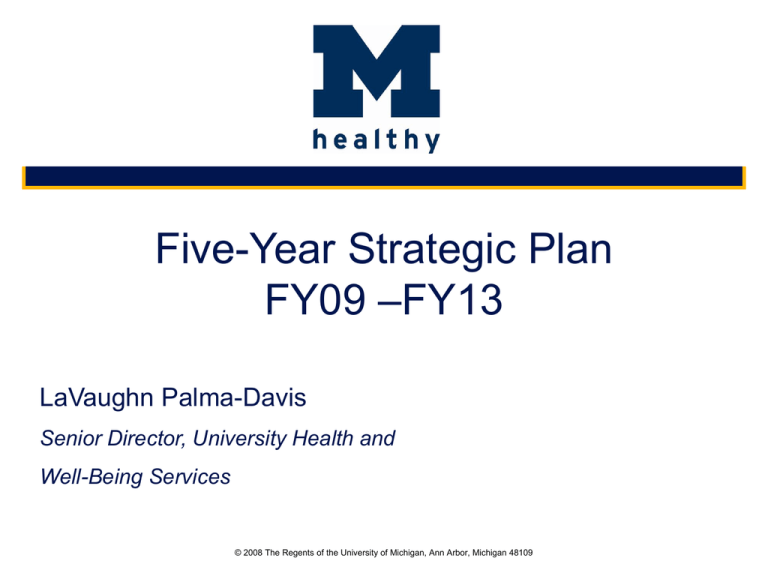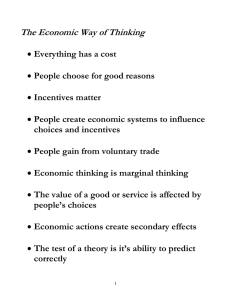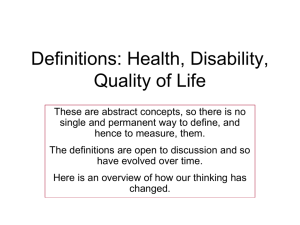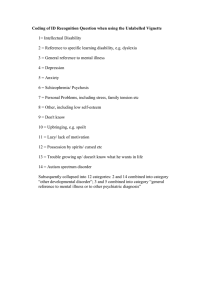
Five-Year Strategic Plan
FY09 –FY13
LaVaughn Palma-Davis
Senior Director, University Health and
Well-Being Services
© 2008 The Regents of the University of Michigan, Ann Arbor, Michigan 48109
Our Unique Opportunity to Improve Health
“We have the means to mount a broad, collaborative effort to
fashion a prototype program to:
•promote healthy living,
•contain health care expenditures, and
•define optimal insurance coverage for individuals and
families.
We can use our intellectual resources to help the nation in
addressing the growing crisis in health care.”
- President Mary Sue Coleman
Future Directions Presentation
UM Regents, 4/22/04
UM Benefit Contributions
Percentage of Total Operating Budget
16.0%
15.0%
14.0%
11.7%
12.0%
10.1%
10.0%
9.3%
Retirement Plan
Medical+Rx
7.5%
8.0%
Other Benefits
7.0%
Total
6.0%
4.8%
4.0%
3.5% 3.3%
4.4%
4.1%
3.8%
2.0%
0.6%
0.6%
0.6%
0.5%
0.0%
FY 1997
FY 2007
FY 2017 Projected
FY 2027 Projected
“Other Benefits” includes dental, LTD, life insurance, opt out cash and Medicare Part B premium
reimbursements; does NOT include University contributions for FICA, nor vacation or sick pay.
3
The Real Cost of Worker Health
Estimated 2006 Median Total Health Cost
per Employee
$718
$434
$1,134
$6,532
Group Health
Turnover
Unscheduled Absence
Non-occ Disability
Workers' Comp
$5,170
Total: $13,988
Source: Goetzel, JOEM, 2001:43(1):
Adjusted to 2006 dollars
Does not include presenteeism costs
Health Care Cost Drivers
Insufficient prevention – 70% of health care costs are related to
lifestyle and safety practices
Growth in chronic illness
Noncompliance and poor self-management
Aging population
Mental illness
Current US health care reimbursement system
Other socio-economic issues
Population Health Management
An Integrated Strategy Across the Health Continuum
Wellness Management Risk Factor
Management
•Information
•Targeted Screening
•Motivation
•Targeted Interventions
•Preventive Screening
•Reinforcement
Demand Management
Disease Management Disability Management
•Self Care Information
•Nurse Advice Line
•Decision Support
•Clinical Management
•Compliance Support
•Case Management
•Decision Support
•Risk Management
Health & Well-Being
At Risk
Acute Illness/Injury
Chronic Disease
Disability
Low Risk
Optimal Health
Inactivity, Obesity,
Stress, High
Blood Pressure
Doctor Visits
ER Visits
Diabetes
Heart Disease
Traumatic Injury
Neurological Conditons
85% of employees; 15% of costs
15% of employees; 85% of costs
Source: David Anderson, Ph.D., StayWell Health Management
16th Annual Art and Science of Health Promotion Conference, 3/24/06
Narrow Focus Misses Key Cost Drivers
59%
of next year’s high-cost group
Health & Well-Being
At Risk
Acute Illness/Injury
Chronic Disease
Disability
Low Risk
Optimal Health
Inactivity, Obesity,
Stress, High
Blood Pressure, High
Cholesterol, Smoking,
Alcohol Use, etc.
Doctor Visits
ER Visits
Diabetes
Heart Disease
Traumatic Injury
Neurological
Conditions
StayWell medical claims study
•Multiple employers/51,200 employees
•5 years of data (1997-2001)
•Compared each year with next
•High-cost 5% = 78% NEW each year!
Source: David Anderson, Ph.D., StayWell Health Management
16th Annual Art and Science of Health Promotion Conference, 3/24/06
15% of employees; 85% of costs
Key Drivers of Health Care
Cost Containment and ROI
Participation – Need to achieve optimal
participation/engagement (70-80+%).
Program effectiveness – Program performance must
be monitored to assure risk reduction is being achieved.
Communications, Culture and Incentives
Drive Engagement
HA Participation Rate (%)
100%
Weaker
Strong
80%
69%
65%
60%
51%
44%
40%
41%
33%
37%
33%
53%
51%
41%
27%
20%
0%
Comm.
Culture
Comm.
Non-Cash
Incentives
Source: StayWell Financial Incentives Impact Study, 2007
Copyright 2007 StayWell Health Management. All rights reserved.
Culture
Cash
Incentives
Comm.
Culture
Benefits-Integrated
Incentives
Vision
The University of Michigan will be a model
community of health where people thrive.
MHealthy:
Five Year Strategic Health and Well-being Plan
Builds upon best practices and research
Considers existing resources and gaps
Identifies foundational priorities, critical to
achievement of MHealthy goals
Guided by principles of rewarding healthy
behaviors, protecting confidentiality and
reducing barriers to health improvement
Effective Population Health Management
An integrated strategy across the health continuum
Healthy
Wellness
Promotion
(Low Risk)
Information
Motivation
Preventive
Screening
Opportunities
to Maintain
Health
At Risk
Risk Factor
Reduction
Targeted
Screening
Targeted Risk
Factor
Interventions
(smoking, high
blood pressure,
lipids, overweight,
etc.)
Reinforcement
Short Term
Illness
Chronic
Diseases
Disability
Use of Health
Care Services
(for Acute
Injury/Illness)
Disease
Management
Disability
Management
Sufficient
Access
Self Care
Information
Help in Making
Treatment
Decisions
Effective and
Timely Clinical
Care
Patient
Education,
Compliance
and Self Care
Skills
Care
Coordination
Care
Coordination
Help in Making
Treatment and
Life Decisions
Risk
Management
Return to
Productivity
The goal is to move people to lower risk and improved health.
Components of Strategic Plan
Leadership support
Supportive environment,
culture & infrastructure
Communication
Data management &
evaluation
Program coordination
Benefit design &
incentives
Wellness assessments
with follow-up coaching
Targeted risk reduction
Disease management
Disability management
Demand management
Innovation
Highlights of Strategic Plan:
Communication
Develop and implement a comprehensive, multi-year
communications plan, including identification of
specific strategies to market/communicate issues,
programs and services and move people to action
Leadership Commitment and Support
-
Provide leadership engagement and training at all
levels
-
Incorporate employee health performance
expectations into leader evaluation process
-
Develop/modify organizational policies to advocate
optimal health
Supportive Environment, Culture and
Infrastructure
-
Develop plan to improve fitness center access
-
Continue to offer fitness center and equipment discounts
-
Expand efforts to establish a smoke-free environment
across the university
-
Sustain and expand other environmental supports in the
areas of physical activity, healthy eating, safety and
cleanliness
Benefit Design and Incentives
-
Establish a cost-effective benefit design that supports
prevention, risk reduction and improved compliance
-
Ensure that design reduces barriers to obtaining care
-
Provide incentives that promote the adoption and/or
maintenance of healthy behaviors
Health Risk Assessments with Follow-Up
Coaching
-
In FY09, launch a University-wide health risk
assessment program with biometric screenings, followup coaching and referral
General and Targeted Interventions
-
Identify existing and new resources for targeted
interventions based on UM health data profile
-
Enhance availability and accessibility of services in key
areas such as: weight mgmt., healthy eating, physical
activity, stress mgmt., ergonomics, back health, tobacco
cessation, and cardiovascular disease prevention
Mental/Emotional Health and Substance
Dependence Services
-
Continue awareness campaign to reduce stigma &
promote prevention
-
Maintain robust website including self-help tools and
resource assistance
-
Conduct manager and HR training
-
Improve the return to work process
-
Complete study of optimal mental health benefit design
and equity/access issues with recommendations
Disease Management Programs
-
Evaluate existing health plan offerings and make
recommendations to assure effectiveness and optimal
utilization
-
Evaluate existing pilot programs (Focus on Diabetes,
Focus on Medicines) for efficacy and determine future
direction
-
Work with the UM/BCN Joint Venture to identify other
valuable pilot programs to address improved approaches
to care
Getting Started – Year 1 FY09
Free and confidential wellness assessments offered to all benefit
eligible employees beginning in January, 2009
On-line health risk questionnaire,
Blood pressure,
Cholesterol, HDL & glucose
Height, weight and waist circumference
Results coaching
Referral to helpful programs and resources at low or no cost
High risk individuals will have an opportunity to have a personal
health coach
$100 incentive for participation in wellness assessment in 2009
FY09 B&F Key Initiatives
3.1 Effective internal implementation and early adoption of
relevant University-wide initiatives
At least 40% of benefits eligible B&F staff will
participate in a free and confidential MHealthy
Wellness Screening by June 30, 2009.
Measuring MHealthy Program Outcomes
1/19/2008
8/11/2009
2/20/2011
12/5/2012
Program Start
Year 1
Years 2 & 3
Year 3 and beyond
Short term metrics
Health assessment
participation rates
Program participation
rates, including
enrolled, and
completion rates
Program satisfaction
Baseline health risks
compared to
benchmarks
Baseline health issues
driving health care
costs and utilization
Medium term metrics
Reduction in health
risks
Pre and post
outcomes for select
behavior change
programs
Healthy culture
indicators
Long term metrics
Health status
improvements
Continued
improvement or
maintenance in health
risk levels
Reduction in health
care cost trend
Impact on avoidable
costs
Health care utilization
Impact on absenteeism
workers comp,
disability
Conclusion
The University has made a commitment to invest in
MHealthy to improve the health of our community and try
to contain future health care costs.
We cannot achieve the high level of participation
necessary to be successful without your leadership
commitment as well.
We will do our part to help you with
Communication tools and messages
Delivering programs in your schools & departments
Creating a supportive environment, policies and
appropriate incentives




